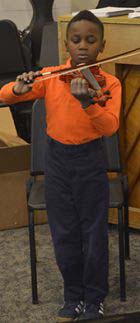Kindergarten student Taylor Blackmon tucked a violin under her chin and began plucking its strings, one by one: E, A, D and G. The exercise was less cumbersome for her today, thanks to a new violin more suitably sized for her unusually short stature.
“There you go,” teacher Patricia Wunder approvingly told Taylor, who clearly was pleased with her pint-sized violin. “It’s easier to pluck,” she said.
Taylor’s happier musical experience came thanks to a $1,475 grant to Wunder’s string music program at her school, Gerald R. Ford Academic Center. The grant from Michigan Youth Arts paid for Taylor’s miniature violin and five larger ones, as well as new bows and cases.
All gave a boost to the Ford music program that serves roughly 200 students, which incorporates stringed instruments into children’s general music instruction. All K-4 students learn how to play the violin. Fifth-graders get a string-orchestraexperience, and sixth- and seventh/eighth-graders have their own orchestras as well as bands.
The new violins, all owned by Grand Rapids Public Schools, are sized to enable students to hold their bows in better playing position. This helps them play tunes with proper technique, such as the rudimentary “Pepperoni Pizza” – a favorite of Taylor’s.
“Having the right-size instrument is going to help the students develop their musicianship,” said Wunder, teaching her third year at Ford. The grant also updates school instruments as old as 50 years, for which there is often not enough money to repair.

Sense of Accomplishment, Pride
For Wunder, it’s another piece in teaching students patience and perseverance as well as notes to songs like “Road to Freedom” and Beethoven’s “Ode to Joy.”
“It’s really fun to see the kids grow in appreciation of music,” said Wunder, who also teaches at Congress and Shawmut Hills elementary schools. “Students are having a lot of ‘aha’ moments: ‘I figured it out!’ There’s this huge sense of accomplishment and pride.”
She keeps handy a note from a student named McKenzie, who wrote, complete with musical notation, “Thank you for teaching me be[a]utiful music Mrs. Wunder. You stab[b]ed an arrow in my heart that made me love music.”
Wunder stokes that love with occasional outings, such as taking students to the Calvin College January Series to see the Earth Harp Collective. But students like McKenzie also learn other things through music, Wunder stressed, noting extensive research on music instruction’s benefits for brain development and math and language skills.
“They’re also learning how to create and problem-solving skills,” said Wunder, who performs with the Holland Symphony and the Simply Strings quartet. “They’re developing self-confidence.”
Her first-graders seemed to gain confidence – and certainly excitement – as they unpacked their new Franz Hoffman instruments one recent morning.
“I like these!” Amari-David Agboyi exclaimed as he took his ¼-size violin out of the case. After playing it he called out to Wunder, “Thank you for the new cases and violins that are just our size.”
“I like the bow and everything,” Daesean Baker said of his instrument. “It’s perfect.”
Wunder took them through their paces – how to hold the bow, how to stand, how to smoothly draw the bow over the strings. She showed them how to play the notes of “Hoedown”: “Here’s D, listen. And then there’s G, listen. That’s great. You’re doing a nice job of learning the notes.”
She ended the class by inviting them to jump up and down while playing, like Youth Orchestra Los Angeles did at the recent Super Bowl halftime show. Her students enthusiastically obliged.
“There’s just really cool things you can do with music,” she said afterward.
CONNECT
TED talk on how playing music benefits the brain
Gerald R. Ford Academic Center










